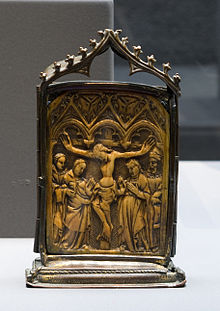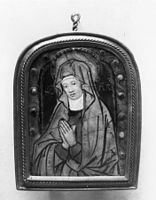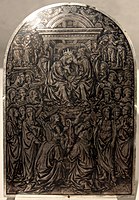Pax (liturgical object)



The pax was an object used in the
The pax began to replace actual kisses in the 13th century, apparently because of a range of concerns over the sexual, social and medical implications of actual kissing. It is first documented in England, and the 17th-century historian of the Mass, Cardinal
Pax was the Latin name, with osculatorium, osculum pacis and instrumentum pacis as alternatives. Pax was also used in English, in which they were also called a pax board and pax-brede, or "paxbrede". Another Latin term was pacificale, still sometimes used in Italian and German.[4] The modern term pax tablet may be used, especially by church historians, where art historians mostly favour "pax".[5] "Osculatory" is used in some 19th-century sources,[6] and some claim that this refers to a pendant form, worn round the neck by the priest. This does not appear in most modern scholarship, though given a one-line entry by Oxford Art Online.[7] Translators unfamiliar with the concept may introduce still further names into English. Kusstafel ("kiss-board") is one of the German names.
History
The Kiss of Peace was included in the Mass of the Western Church from the 2nd century at least, and the Eastern Church had its equivalent. The kiss was only supposed to be exchanged between members of the same sex, but numerous references to inter-sex kissing show that this continued to be a possibility.
The pax board, as a substitute for the Kiss of Peace, is first mentioned in 1248 in the statutes of the
Early texts of the major work Rationale divinorum officiorum by Guillaume Durand, Bishop of Mende in southern France,[14] which was circulating from 1286, do not mention the pax. But the first vernacular translation, in French from 1382, has an inserted mention of "la paix porter".[15] A synod in Prague in 1355 is the first mention from the Holy Roman Empire; the synod recommended that the pax should be introduced if congregations were reluctant to exchange actual kisses.[16] Other evidence, including surviving paxes, shows it spread at least to Italy, Germany and Spain, and was probably standard in Western European churches by the Reformation.[17]
In
By about 1600 the use of the Kiss of Peace had declined and changed in Catholic practice as well. No longer regarded as a general ceremony of reconciliation, but as one of greeting those deserving honour, it was now restricted to the clergy and the choir, as well as magistrates and male nobility. It was performed at the beginning of High Mass, whereas the pax board had previously been more often associated with the less ceremonial Low Mass. According to the Oratorian liturgical historian Father Pierre Lebrun (1661–1729), the decline in Catholic use was because of the disputes over precedence that it caused.[19]
Another factor may have been that kissing the pax had clearly come to act as a substitute for receiving the Eucharist for many of the faithful, avoiding the need for fasting and other prescribed preparations for Holy Communion.[20]
In modern Catholicism use of the pax is confined to a few religious orders, such as the Dominicans,[21] and individual churches.
Cause of disputes

As earlier with the actual kiss, the pax was often the cause of bad feeling and sometimes actual violence because the order in which it was kissed, descending down the religious and social hierarchy, gave rise to disputes over precedence.
And yet is there a private species of Pride that waits first to be greeted ere he will greet, although he is less worthy than that other is, indeed; and also he expects or desires to sit, or else to go before him in the way, or kiss the pax, or be incensed, or go to the offering before his neighbor, and such similar things, beyond what duty requires, indeed, but that he has his heart and his intent in such a proud desire to be made much of and honored before the people.[22]
In
The historian Eamon Duffy in his The Stripping of the Altars recounts that:
In 1494 the wardens of the parish of All Saints, Stanyng, presented Joanna Dyaca for breaking the paxbrede by throwing it on the ground, "because another woman of the parish had kissed it before her." On All Saints Day 1522 Master John Browne of the parish of Theydon-Garnon in Essex, having kissed the pax-brede at the parish Mass, smashed it over the head of Richard Pond, the holy-water clerk who had tendered it to him, "causing streams of blood to run to the ground." Brown was enraged because the pax had first been offered to Francis Hamden and his wife Margery, despite the fact that the previous Sunday he had warned Pond, "Clerke, if thou here after givest not me the pax first I shall breke it on thy hedd."[25]
On the other hand, a "ribald carol" where a female narrator recounts various flirtatious advances made at mass includes the verse:
- "Jankin at the Agnus bered the pax-brede;
- He twinkled but said nout, and on my fot he trede
- Kyrieleison"[26]
As art
Paxes with elaborate metalwork framing an image in a medium that would withstand kissing and wiping are the sort that have been most likely to survive. Other objects that might seem to have had another purpose, such as
As a type of object that was not quite considered of top importance, the compositions in pax images were very often recycled from another medium such as prints or plaquettes. Gilt-copper is more common than gold in the surrounds, and gems were likely to be glass-paste. But this is also partly an accident of survival; many paxes were made purely of a single piece of silver, with the image in
From inventories and other records we know that churches very often had two or more paxes, distinguishing between the best, for feast-days and probably typically of metal, and "ferial" or everyday ones, probably often in wood. Many churches also had pairs of paxes, one used on each side of the central aisle. A rare medieval wood pax was found under floorboards in a cottage near the church at
English documentary records during the English Reformation, and especially the brief restoration of Catholic practices in the reign of Mary I of England, record a variety of forms of pax, including some in the 1550s that are clearly improvisations replacing the objects confiscated earlier. In one parish a mass-book with a treasure binding was used, at others a small shield with a gentleman's coat of arms on, and an object showing "a nakyd man with the xij sighnes aboute him".[33]
-
Rear of the German 15th-century Eberbach Pax, with handle and engraved saints
-
Unusually fancy North Italian pax, including relics, 1434, Trento Cathedral, 33 cm high
-
Italian, c. 1500 with Christ as the Man of Sorrows, 18 cm high
-
German Late Gothic pax with a relic under glass or crystal, c. 1500
-
Pax with theshell cameo, gilded silver, copper, enamel. German or Netherlandish shell carving (c. 1500), setting probably Italian(c.1500–1520)
-
Ivory pax with Crucifixion, Netherlandish, 1500–10
-
Late Gothic pax from Maastricht, the image under crystal or glass
-
16th-century cast copper pax, Italian
-
Painted Limoges enamel, 1520-40 by Nardon Pénicaud, 8.3 cm high
-
Italian, painted enamel and gilt-copper frame, early 16th century. The main image after a plaquette. 19 cm high
-
Side view of a pax showing the handle
-
Master E.S., c. 1480, mounted in silver as a pax in 17th century
Notes
- ^ Oxford; CE
- ^ CE
- ISBN 9780898706772– via Google Books.
- ^ Mantello and Rigg, 163; Oxford; Kuhn, pp. 725–726, under "pax" and "paxbrede"
- ^ Harvey uses "pax board"; Duffy and museums such as the Walters Art Museum, source of most of the images here, use "pax".
- OED, "Osculatory"
- ^ "osculatory." The Concise Oxford Dictionary of Art Terms. Oxford Art Online. Oxford University Press, accessed May 31, 2015, online
- ^ Harvey, 23–24
- ^ Oxford
- ^ Jungmann, Joseph (1951). The Mass of the Roman Rite: Its Origins and Development. Milwaukee: Benzinger Brothers. pp. 327–328.
According to an old French custom, however, the priest gave the Kiss of Peace to the groom in a bridal Mass, who in turn imparted it to the bride.
- ^ Maskell, William (1882). Monumenta Ritualia Ecclesiæ Anglicanæ ; the occasional offices of the church of England according to the old use of Salisbury, the Prymer in English, and other prayers and forms (2nd ed.). Oxford: Oxford, Clarendon Press. p. 74.
A manuscript pontifical in the library of Magdalen College, Oxford, of the twelfth or thirteenth century, has in this place the rubric, "Hic osculatur sponsus sacerdotem, et potestea suam sponsam."
- ^ Duffy, 29; Harvey, 23
- ^ Harvey, 20–21
- ^ Mende, Lozère, Languedoc-Roussillon
- ^ Harvey, 21
- ^ Harvey, 21
- ^ Harvey, 21–23; Oxford
- ^ Harvey, 24–28
- ^ Senn, 188–189
- ^ Harvey, 22; Duffy, 125
- ^ "The Pax Instrument", Fr. Augustine Thompson, O.P.
- ^ Translation by L.D. Benson, Harvard
- ^ Duffy, 12
- ^ Harvey, 24
- ^ Duffy, 126–127
- ^ Duffy, 12; Jolly Jankyn, text
- ^ 12th-century enamel example, British Museum
- ^ Stratford, items R1139-40, commentary on p.375
- ^ Alexander and Binski, 240
- ^ Willy Schmidtt-Lieb, "Künstlerische Impressionen von Kloster Eberbach" in Der Hessische Minister für Landwirtschaft und Forsten, Freundeskreis Kloster Eberbach e.V. (Ed.): Eberbach im Rheingau. Zisterzienser – Kultur – Wein. Der Hessische Minister für Landwirtschaft und Forsten, Wiesbaden/Eltville 1986, pp. 161–163; an example from Aachen
- ^ Marks and Williamson, 414–415; both the Stanton and New College paxes were exhibited.
- ^ V&A page
- ^ Duffy, 562
References
- Jonathan Alexander & Paul Binski (eds), Age of Chivalry, Art in Plantagenet England, 1200–1400, Royal Academy/Weidenfeld & Nicolson, London 1987
- "CE" = "Pax." The Catholic Encyclopedia. Vol. 11. New York: Robert Appleton Company, 1911. accessed 30 May 2015 online
- Duffy, Eamon, The Stripping of the Altars, 1996, Yale UP, Google Books
- Harvey, Karen, The Kiss in History, 2005, Manchester University Press, ISBN 071906595X, 9780719065958
- Kuhn, Sherman M., Middle English Dictionary, Part 2, 1982, University of Michigan Press, ISBN 0472011626, 9780472011629, Google Books
- Mantello, Frank Anthony Carl and ISBN 0813208424, 9780813208428
- Marks, Richard and Williamson, Paul, eds. Gothic: Art for England 1400–1547, 2003, V&A Publications, London, ISBN 1851774017
- "Oxford" = "Pax", The Oxford Dictionary of Christian Art and Architecture, Authors: Tom Devonshire Jones, Linda Murray, Peter Murray, 2013, OUP Oxford, ISBN 0199680272, 9780199680276
- Senn, Frank C., The People's Work: A Social History of the Liturgy, 2010, Fortress Press, ISBN 1451408013, 9781451408010, Google Books
- Stratford, Jenny, Richard II and the English Royal Treasure, 2012, Boydell Press, ISBN 1843833786, 9781843833789
Further reading
- J Williams, "A Wooden Pax At Sandon", Transactions of The Essex Archaeological Society, 22 (1940), 37–44
- John Bossy, "The Mass as a Social Institution, 1200–1700," Past and Present, 100 (August 1983), JSTOR
External links
- Paxes in the Victoria and Albert Museum
- 601 images of 271 objects, Gothic Ivories Project at The Courtauld Institute of Art, London













